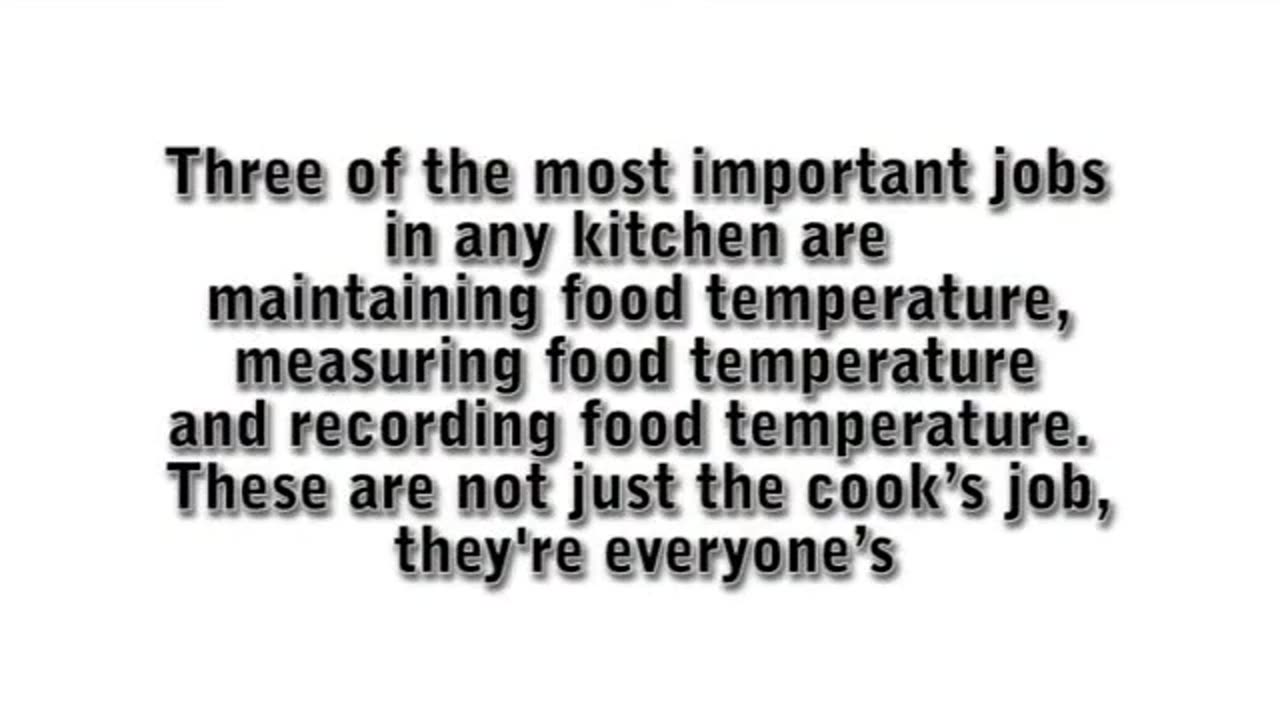Premium Only Content

Food Handler Training Course_ Part 4
### **Food Handler Training Course (Part 4) – Safe Food Storage**
Proper food storage is essential to maintaining food safety, preserving food quality, and preventing contamination. As a food handler, understanding safe storage practices helps protect customers from foodborne illnesses and ensures compliance with food safety regulations.
---
### **Objectives of Part 4**
1. Learn the principles of proper food storage.
2. Understand how to prevent contamination in storage areas.
3. Recognize best practices for organizing and maintaining storage spaces.
---
### **Importance of Safe Food Storage**
1. **Prevents Foodborne Illness:**
- Proper storage reduces the risk of bacterial growth and contamination.
2. **Preserves Food Quality:**
- Protects food from spoilage and maintains freshness.
3. **Complies with Regulations:**
- Adheres to food safety laws and guidelines, preventing penalties or closures.
---
### **Key Food Storage Principles**
#### **1. Temperature Control**
- Store food at the correct temperatures to prevent spoilage and bacterial growth:
- **Refrigerated Foods:** 0°C to 5°C (32°F to 41°F).
- **Frozen Foods:** -18°C (0°F) or lower.
- **Dry Foods:** 10°C to 21°C (50°F to 70°F) in a cool, dry area.
#### **2. FIFO System (First In, First Out)**
- Rotate stock to use older products first and reduce waste.
#### **3. Labeling and Dating**
- Clearly label all food items with their contents and the date of preparation or receipt.
- Include expiration dates to ensure foods are used within their safe timeframes.
#### **4. Proper Organization**
- Store food in a clean, organized manner to prevent cross-contamination.
- Use separate storage areas for raw and ready-to-eat foods.
---
### **Storage Best Practices**
#### **1. Refrigeration**
- Keep perishable items in the refrigerator at or below 5°C (41°F).
- Store raw meats, poultry, and seafood on the bottom shelves to prevent drips onto other foods.
- Avoid overloading the fridge to allow proper air circulation.
#### **2. Freezing**
- Freeze food immediately if it will not be used within a few days.
- Wrap items tightly to prevent freezer burn.
- Defrost frozen foods in the refrigerator, cold water, or microwave—not at room temperature.
#### **3. Dry Storage**
- Keep dry foods in sealed, labeled containers.
- Store items off the floor and away from walls to prevent pest infestations.
- Check for signs of spoilage or damage, such as bulging cans or torn packaging.
---
### **Preventing Contamination in Storage Areas**
#### **1. Physical Contamination**
- Use clean, food-safe containers for all stored items.
- Keep storage areas free of dirt, debris, and broken equipment.
#### **2. Chemical Contamination**
- Store cleaning products and chemicals away from food storage areas.
- Use food-grade containers and wraps to avoid contamination.
#### **3. Biological Contamination**
- Regularly clean and sanitize storage areas, including shelves and bins.
- Ensure proper temperature control to prevent bacterial growth.
---
### **Common Food Storage Mistakes to Avoid**
1. **Storing Raw and Cooked Foods Together:**
- Always separate raw foods from ready-to-eat items.
2. **Overpacking Refrigerators or Freezers:**
- Overloading can block airflow, leading to uneven cooling.
3. **Failing to Check Expiry Dates:**
- Regularly inspect stored foods and discard expired items.
4. **Leaving Foods Uncovered:**
- Cover all stored foods to protect them from contamination and drying out.
---
### **Examples of Safe Storage Practices**
**Scenario 1:** A chef receives a delivery of raw chicken, vegetables, and canned goods.
- **Safe Practice:** Store raw chicken on the bottom shelf of the refrigerator, vegetables on higher shelves, and canned goods in a cool, dry pantry.
**Scenario 2:** Leftover soup needs to be refrigerated.
- **Safe Practice:** Cool the soup quickly using shallow containers before placing it in the refrigerator.
---
### **Storage Checklist for Food Handlers**
- ✅ Maintain the correct storage temperatures for all food types.
- ✅ Label and date all stored foods.
- ✅ Use the FIFO system for inventory management.
- ✅ Keep storage areas clean and free from pests.
- ✅ Regularly inspect food for spoilage or contamination.
---
### **Tips for Success**
- Conduct regular training sessions on safe storage practices for all employees.
- Use thermometers to monitor refrigerator and freezer temperatures.
- Schedule routine cleaning and pest control for storage areas.
---
### **Conclusion**
Safe food storage is a cornerstone of food safety. By following best practices for temperature control, organization, and contamination prevention, food handlers can ensure the safety and quality of the food they serve.
---
Would you like to proceed to **Part 5: Cleaning and Sanitizing** or revisit another topic?
-
 6:43
6:43
HSESafetyInformation
7 months agoLahori Chanay Recipe - Lahori Cholay Recipe - Chana Chana Masala
57 -
 25:10
25:10
MYLUNCHBREAK CHANNEL PAGE
5 hours agoIstanbul Should NOT Exist - Pt 4
10.7K6 -
 LIVE
LIVE
tminnzy
4 hours agoDROPS ON - BO7 BETA ALL DAY! #BlackOps7
57 watching -
 1:35:48
1:35:48
Jeff Ahern
4 hours ago $8.15 earnedThe Saturday Show with Jeff Ahern
57K5 -
 LIVE
LIVE
GritsGG
5 hours agoWarzone Win Grinding! Most Wins in WORLD! 3680+!
148 watching -
 55:45
55:45
Tactical Advisor
4 hours agoNew Product Alert! | Vault Room Live Stream 040
44.6K4 -
 3:30:37
3:30:37
Reidboyy
4 hours ago $1.33 earnedTHEY GOT RID OF SBMM WTF!?!? (Go Phillies)
19.2K -
 LIVE
LIVE
The Company Boyz
3 hours agoDying Light: The Beast | Ja Pierdole, Kurwa Bober!
67 watching -
![Mr & Mrs X - Feminism, Family, Federal Reserve, The Rise Of The [DS] Agenda](https://1a-1791.com/video/fwe2/12/s8/1/6/F/R/n/6FRnz.0kob-small-Mr-and-Mrs-X-Feminism-Famil.jpg) 58:10
58:10
X22 Report
11 hours agoMr & Mrs X - Feminism, Family, Federal Reserve, The Rise Of The [DS] Agenda
198K53 -
 16:37
16:37
Robbi On The Record
1 day ago $8.85 earnedThe Theater of Manufactured Outrage - When Left and Right Dance for the Same Puppet Master
49.5K50
